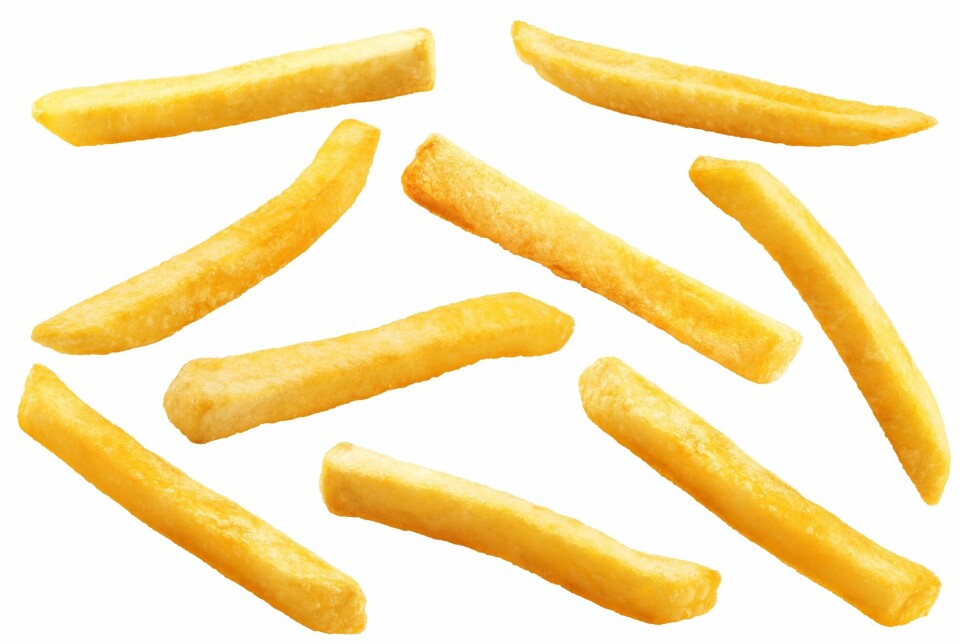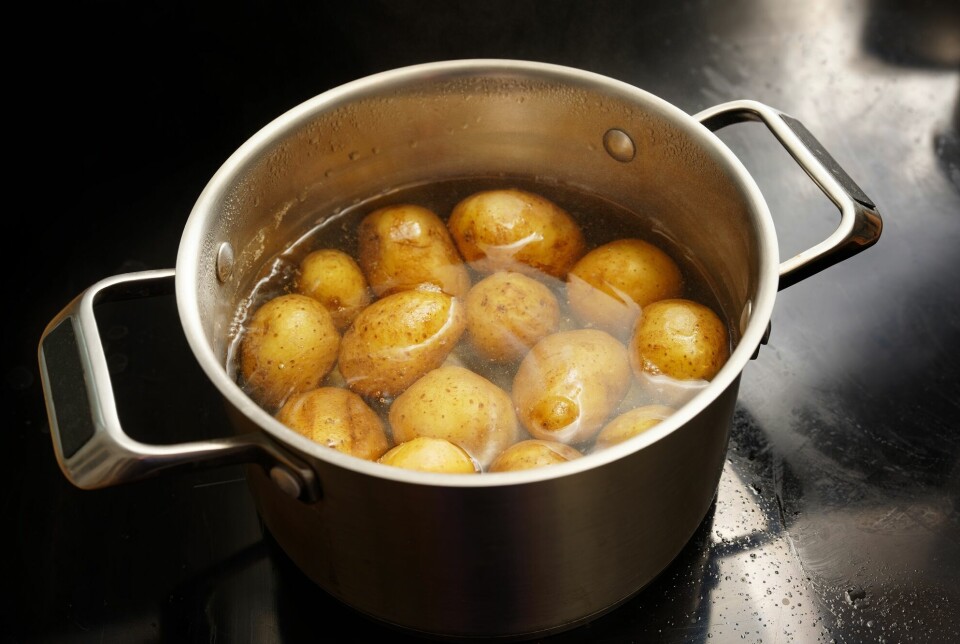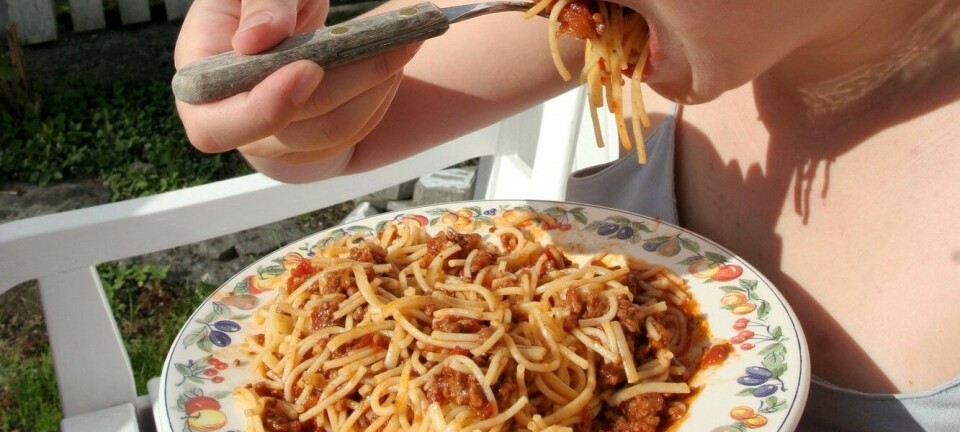
Is it possible to make healthy french fries?
Potatoes are healthy. So why aren't french fries healthy?
The boiled potato has fallen out of favour on the Norwegian dinner table since the 1950s, when Norwegians ate around 90 kilos of potatoes a year.
Statistics show that as of 2022, Norwegians eat more processed potatoes than unprocessed potatoes.
Processed potatoes are foods such as crisps or french fries. More than half of the potatoes eaten in Norway today are processed. A lot of these potatoes come in the form of french fries.
But if the potato is healthy, isn't everything made from potatoes a little healthy too?
First of all: Fat and overeating
“Nothing is always unhealthy and always healthy,” says Jacob Juel Christensen.
He is a nutritionist at the University of Oslo.
“But in general, most people can agree that deep-fried french fries are unhealthy, partly because there is too much fat compared to potato, which contributes to overeating,” he says.

Tine Sundfør completely agrees that french fries are unhealthy.
“The issue lies in what you add to it,” she says.
Sundfør is a trained clinical nutritionist and has a doctorate in nutrition.
“Yes, they’re potatoes, but french fries also include fat and salt, and some even include a little sugar in the frying oil. The fat is left to soak in, which makes the fries very energy-dense. Before you know it, you've consumed far more energy than you need, but you may still be craving more. There are a lot of calories in french fries, but little fibre and protein, so they don’t make you feel very satiated,” she says.
Fat instead of water
In other words, eating three boiled potatoes requires some effort, and they fill you up quite well. You might not even finish them all, but that's fine since they satisfy your energy needs.
If you take the same three potatoes and make french fries out of them, there's a good chance you'll gobble them quickly, without feeling full afterwards. And the amount of energy you get is much more than you need, because you’re not simply eating potatoes, but also a lot of fat.
The potato naturally contains a lot of water, Christensen explains. When a food is deep-fried, the water is replaced with fat.
Instead of a boiled potato with a lot of fibre and water, which will be satiating, french fries consist of a small amount of potato, very little water, and a lot of fat, leading us to consume more than we should.
The second problem: Salt
To make french fries, potatoes are cut into sticks. This creates a lot of surface area that is then covered in fat – and salt.
“Sugar, fat, and salt are the substances that most affect the brain’s reward centre and that make us want to eat more,” Sundfør says.
“When it comes to french fries, the taste is linked to being salty, that's sort of the flavour. All this salt, combined with the amount of fat, makes it easy to eat even after you're full."
Most of the salt we consume is not what we add to our food ourselves; it's salt that has already been added to the food we buy.
Too much salt can cause higher blood pressure, which in turn greatly contributes to the first problem with french fries, which is overeating.
Third: The foods you eat them with
“Fries are not exactly served next to boiled cod, but usually with food that's already full of fat and calories,” Sundfør says.
A piece of chicken breast or cod with vegetables on the side is not too bad with fries, according to the nutritionist.
“But you often eat them with a burger. And even if it's a fish burger, it's usually breaded,” she says.
Fish and chips are consequently not much healthier than a meat-based burger meal. Unless it's a fairly large piece of fish with very little breading.

These meals are also made so that they can be eaten on the go. This also means you feel less satiated, according to Sundfør.
“We gobble these meals up quickly. We eat with our fingers and eat faster, and the feeling of fullness sets in later,” she says.
How often is okay?
If you don’t eat french fries very often, it’s not a crisis if you eat them occasionally, according to Sundfør.
But what counts as occasionally?
The answer depends on what else you eat.
“If you never eat crisps, you can eat fries once a week. If you like crisps, then once a month is enough,” the nutritionist says.
Many Norwegians eat a lot of french fries during the times they are on holiday in warmer climates.
If you otherwise don’t eat hotdogs and burgers, you can eat a few more fries.
“Nothing is unhealthy in small quantities. It’s the overall diet that matters," she says.
Norway, for now, is in a fortunate position, Sundfør notes. Despite half of the potatoes consumed being processed, the french fries culture has not embedded itself as deeply as in some European countries and the US.
On holiday in the mountains with family from the UK, Sundfør was surprised when fries were ordered as a side dish for Greek salad and soup.
“They thought it was completely normal. But this is destroying Norwegian food culture. We are changing what is considered the norm. Fortunately, people still eat a lot of fresh potatoes in Norway. It’s important that we don’t let our food culture deteriorate so that fries are something we eat with everything,” she says.
What about fries from the freezer?
Sundfør, Christensen, and dietary guidelines maintain that boiled and baked potatoes are the healthiest.
What about french fries from the freezer that have been baked in the oven at home?

Christensen does a quick search on the internet to check the contents of the bags. The bag he looks at more closely has no added salt.
“Frozen french fries that you put in the oven... they have quite a bit more energy, a slightly higher content of carbohydrates. I'd say they're probably not that bad. They're not exactly like their deep-fried counterparts but still, they can lead to overeating," he says.
“You add less fat, so there are slightly fewer calories. But there's already some fat in them beforehand, so that they will be crunchy, and then you eat more than you need," Sundfør says.
Potato wedges with the skin on
Sundfør would rather that people make potato wedges – preferably with the skin on, to preserve the vitamins.
"Then you can also control the cooking time and choose a good olive oil with a more beneficial composition. This is a good alternative," she believes.
The choice of oil matters here, according to the nutrition expert.
“Choose a good olive oil, which has a healthier composition than other vegetable oils,” Sundfør recommends.
“Before, people misunderstood and thought that olive oil couldn't withstand high heat, but that’s not true. It's only when you have fried things at the highest temperature on your stovetop for 20 minutes that harmful substances can form, but by then, the food is burnt anyway.”
At the same time, you don't need to use the most expensive cold-pressed olive oil. A cheaper hot-pressed variety will suffice.
“Extra virgin olive oil is made from olives that have not been heat-treated. Some of the beneficial plant compounds, called polyphenols, which the oil contains will be destroyed by heating. So, use a cheaper refined oil for cooking, and save the most flavourful one for salads, pizza, or dipping bread,” the nutritionist says.
Sundfør is often asked whether sweet potato fries are healthier. They are not.
“They're made with just as much fat and salt, and often a lot of salt because they're so sweet on their own,” she says.
As with the potato, it depends on how it is prepared and what is added.

Eat potatoes for the planet!
We should eat more potatoes, according to the new Nordic dietary guidelines. But is it really true that potatoes are that healthy?
“The potato itself seems to be quite neutral for health,” says Christensen, who helped summarise the research behind the new guidelines.
“They're neither good nor bad in terms of developing chronic diseases like heart disease or cancer,” he says.
It's what the potato is compared to that often makes it appear more favourable. For example, it is healthier to eat more potatoes and less meat.
“Potatoes are a good staple food. If you compare them to rice and pasta, which are often eaten instead of potatoes, the potato is by far the best food to consume,” he says.
Why potatoes are better than rice and pasta
Potatoes have more vitamin C and fibre, and fewer calories, than pasta and rice. They also contain high-quality protein and other essential nutrients such as niacin, folate, and potassium.
“Boiled and baked potatoes are also very filling and can help regulate weight,” Christensen says.
But that’s not the only reason why dietary guidelines recommends eating more potatoes.
“It's also because potatoes are so incredibly good for the climate. They’re cheap to produce and have a low climate footprint. The potato is an important part of the climate solution,” Christensen says.
———
The image at the top is from grey_and / Shutterstock / NTB.
Translated by Nancy Bazilchuk
Read the Norwegian version of this article on forskning.no






































